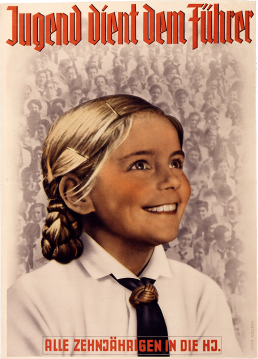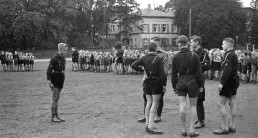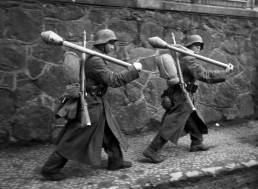Integration into the Volksgemeinschaft
Nazi propaganda persuaded the children of the Volksgenossen that they were part of a superior Volksgemeinschaft (national community), giving them the feeling that they belonged to a Herrenrasse. Many young people readily accepted this idea.
National Socialism permeated the lives of children and young people, from the family to school to the Hitler-Jugend (Hitler Youth, abbreviated HJ), the youth organization in which almost all young Germans were involved. They were indoctrinated in the cult of the Führer, soldierly virtues, an ethno-nationalist worldview, and the cult of a healthy body.
School in the National Socialist era. Celebration in a Berlin elementary school on the anniversary of the founding of the German Reich in 1871, January 18, 1934.
In 1934 the Hitler salute became mandatory in German schools. National Socialist-influenced curricula and textbooks, especially in the subjects of history and biology, taught “racial studies.” As early as 1933, many teachers were already members of the Nazi Party and urged their students to join the Hitler Youth.
(Bundesarchiv)
Indoctrination and the Cult of the Führer: advertising posters designed by the Press and Propaganda Office of the Reich Youth Leadership, c. 1939.
In 1936, the HJ was declared the sole state youth organization, and from 1939 onward membership was compulsory for German children and teenagers. But even before that, many had already joined voluntarily. The HJ was the Nazi Party’s youth organization and a state educational institution at the same time. It indoctrinated its members to absolute obedience and devotion to Hitler and the Volksgemeinschaft.
(Deutsches Historisches Museum)
"Your body belongs to the nation": athletics pageant at the HJ sports festival in Essen, 1938.
Sports and military training played a central role in the education of children and young people. They were called upon to be constantly ready to perform. At the same time, sports was a means of fostering ideological indoctrination and preparation for war.
(NS-DOK Köln)
From the HJ to the SS: Waffen-SS propaganda postcard, Vienna, c. 1943.
The HJ was not only an organization for ideological indoctrination, it also provided military training. The quasi-military camps with marching drills and combat and weapons training were intended to prepare the boys in the HJ for their deployment in the war.
(Deutsches Historisches Museum)
SS-Rottenführer Hans Stark in Buchenwald Concentration Camp, 1939.
Many concentration camp guards were not yet of age. Hans Stark, an enthusiastic Hitler Youth, joined the SS at a very early age. At only 16, he was assigned to the guard detail at Oranienburg Concentration Camp and was transferred to Buchenwald Concentration Camp in 1938. There he looked after the horses of a cavalry platoon, but was also deployed for guard duty. Later, Hans Stark was among the SS troops deployed to the Dachau and Auschwitz Concentration Camps. In the Frankfurt Auschwitz trial, the court found him guilty of having been complicit in murder and sentenced him to 10 years in juvenile detention. He died in 1991.
(Gedenkstätte Buchenwald)
SA for kids: HJ patrols. Hitler Youth propaganda photo.
The HJ patrols imitated the acts of persecution committed by the SA and SS. Children and young people who were seen as enemies could expect to be beaten up in the streets. During the war, the HJ patrols were also used as auxiliary police, to guard forced laborers, for example.
(NS-DOK Köln)
"Jugend führt Jugend": Jungvolk in Lippstadt, 1942.
Jugend führt Jugend (the young leading the young) was the propagandistic motto for the HJ program that trained its members to become HJ leaders. During World War II, the Wehrmacht (the German armed forces) drafted many older HJ members for military service. In many cases, inexperienced younger boys took over the leadership positions. Membership in the HJ, especially in the Jungvolk (the HJ division for boys 10-14), thus became less attractive than before.
(Lippstadt City Archive)
From the Hitler Youth to the Front: Young people armed with bazookas and carbines march to war in Lower Silesia, March 30, 1945.
In March 1945, compulsory military service was extended to those born in 1929. This meant that even 15-year-olds had to join the Wehrmacht, the Waffen-SS or the Volkssturm. Many of the boys sent to the front were untrained.
(Bildarchiv preußischer Kulturbesitz)
FURTHER INFORMATION:
Exhibition, NS Documentation Center of the City of Cologne: Jugend im Gleichschritt!? Die Hitlerjugend zwischen Anspruch und Wirklichkeit.
museenkoeln.de.
Lebendiges Museum Online: Der Bund Deutscher Mädel (BDM).
dhm.de.
Herrenkinder and Outcasts
Excluded – Persecuted – Murdered
Children of Gemeinschaftsfremden (lit.: strangers to the community, those people who were not considered to be part of the Volksgemeinschaft) were marginalized and persecuted in the Nazi…










